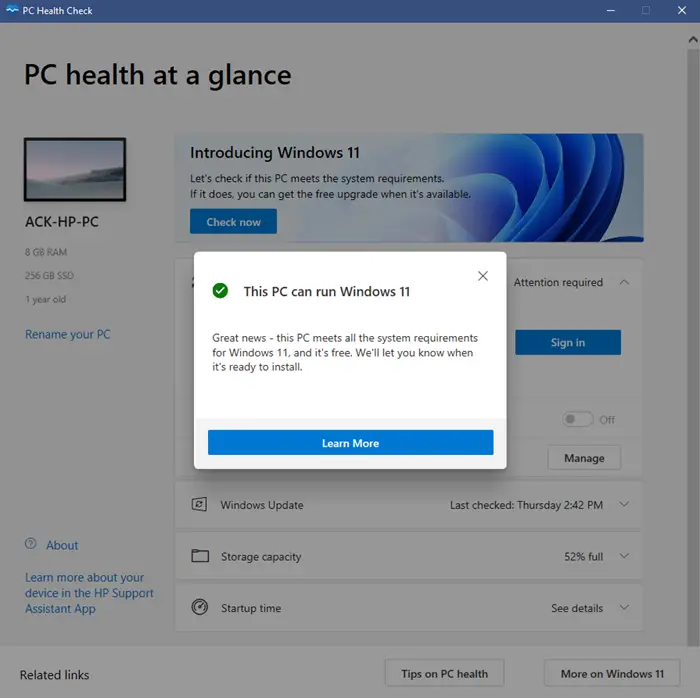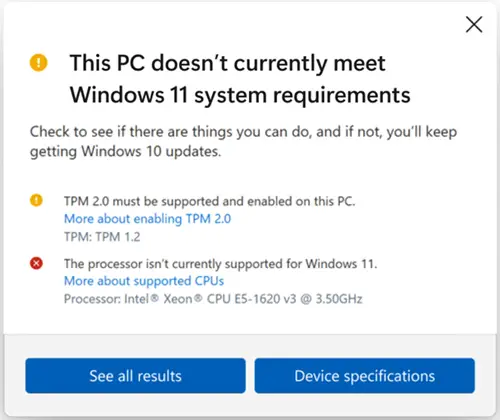Windows 11 is said to be a much-improved version of Windows 10 that will be available as a free upgrade! With all the new features and tools, it is obvious the system requirements for Windows 11 would be a bit different. Microsoft has released a tool that allows you to check if your PC will be able to run Windows 11.

How to check if your PC can run Windows 11
The easiest method to check if your PC will run Windows 11 is to run the system requirements checker as follows:
- Download the PC Health Check tool from Microsoft and run it on your PC.
- When your download the tool, it will check for PC health status.
- Thereafter, under the Introducing Windows 11 option, click on Check now.
- If you get the reply This PC can run Windows 11, you will be able to install Windows 11 on your system.
- Else, you would have to upgrade your system.
Once you get the approval message to install Windows 11, this means that your PC meets the Windows 11 System Requirements. The tool will also mention that you will be further notified when Windows 11 is ready to be installed. In case you install this tool after the launch of Windows 11, possibly, you might get an option to install the operating system on your system for free.
Read: How to check if your PC is compatible with Windows 11 22H2
You can download the PC Health Check tool here from Microsoft.
This post will help you if PC Health Check is not opening, working or showing results.
UPDATE: 27th Aug 2021. Microsoft has now provided three versions that support 64-bit Windows, 32-bit Windows plus Windows on Arm and Windows 10 for S mode PCs.
How to use Windows 11 Compatibility Checker Tool
To verify your architecture, please review the following steps:
- Click the Start button
- Type About
- Launch the About your PC system application
- Verify the following:
- If Edition shows “Windows 10 Home in S mode”, please select the S mode download.
- If System Type shows “64-bit operating system”, please select the 64-bit download.
- If System Type shows “32-bit operating system” or any Arm version is displayed, please select the Arm or 32-Bit download.

This updated version expands the eligibility check functionality with more complete and improved messaging on eligibility and links to relevant support articles that include potential remediation steps
Does it help? Please let us know in the comments.
NOTES:
- WhyNotWin11 is a system requirement and compatibility checker tool that will scan your hardware and tell WHY your PC is not compatible with Windows 11.
- Checkit is another tool that will tell you in detail why your PC does not support Windows 11.
- Windows 11 Compatibility Check Tool is another similar tool that suggests fixes too.
- Windows 11 Requirements Checker Tool checks if your PC is compatible.
- Windows 11 Check & Enable will check if your PC meets hardware requirements.
- See this post, if you receive This PC can’t run Windows 11 message, even when your PC ran Windows 10.
- Microsoft confirms that the Windows 11 PC Check Tool needs more work. Microsoft has released an update to the tool that may tell you why you cannot upgrade.
However, just like with Windows 10, the minimum requirements are not sufficient to run an operating system smoothly. Most users upgraded to 4GB RAM when they understood that the minimum 2GB RAM for a 64-bit system was barely sufficient for the installation. Now, with requirements like a 64-bit processor with 2 cores, running Windows 11 needs quite an upgrade from Windows 10 capable systems.
TIP: See this post if while using the PC Health Check app on your computer, if you get Your organization manages updates on this PC message.
It should also be noted that while the minimum system requirements would allow you to install Windows 11, all features wouldn’t since the new operating system has feature-specific requirements, too.
Read: What to know about Windows 11 before upgrading
How to check the hardware specifications of my Windows computer?
To find system information and computer hardware specs in Windows 11/10, you can use built-in system information tools or a free software:
- Using the msinfo32 tool – Open CMD, type msinfo32 and hit Enter
- Find system information using Command Prompt -Open CMD, type systeminfo and hit Enter
- Using free software to find hardware specs – BGInfo, CPU-Z, Free PC Audit, etc. are some good free ones.
Read: